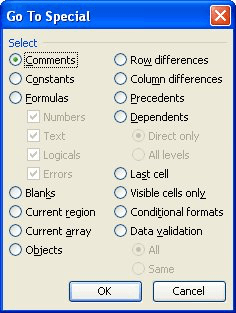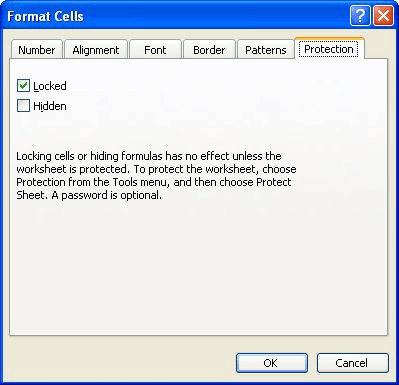Please Note: This article is written for users of the following Microsoft Excel versions: 97, 2000, 2002, and 2003. If you are using a later version (Excel 2007 or later), this tip may not work for you. For a version of this tip written specifically for later versions of Excel, click here: Locking All Non-Empty Cells.
Written by Allen Wyatt (last updated December 19, 2020)
This tip applies to Excel 97, 2000, 2002, and 2003
Sandeep has a worksheet that has hundreds of rows and columns. Some of the cells have information in them and some are empty. The empty cells are used for data entry. He would like a way to easily lock all the non-empty cells in a selected range and then lock the worksheet.
This is rather easy to do manually. There is an important item to keep in mind, however: All the cells in the worksheet are "locked," by default. In other words, you don't need to look for a way to lock the non-empty cells; you only need to look for a way to unlock the empty ones. (There is one exception to this, addressed shortly.)
With this in mind, you can follow these steps to get your empty cells unlocked:

Figure 1. The Go To dialog box.

Figure 2. The Go To Special dialog box.

Figure 3. The Protection tab of the Format Cells dialog box.
That's it. You can now lock your worksheet and only those blank cells that were selected at the end of step 5 will be accessible.
One interesting thing to note is that you don't really have to select a range in step 1. If, instead, you select a cell within the main body of your worksheet's entries, Excel assumes that you want to operate on the used area of your worksheet. In other words, when you get to step 5 what will be selected are all the empty cells in the used area of you worksheet.
One more thing to be aware of is that once you set the locking status of a cell (step 8), the cell retains that status until you specifically change it. This means that if you've previously made changes to the locking status of the cells, it may be beneficial to explicitly lock the cells prior to unlocking the empty ones. You can do this by following these modified steps:
In this case you must perform step 1—you have to select a range to affect. Excel won't assume which range you want to affect as in the earlier comment.
If you prefer, you can use a macro to protect your cells and your worksheet:
Sub UnlockEmptyCells()
Dim myCell As Range
Set myCell = Selection
Cells.Select
Selection.Locked = True
myCell.Select
Selection.SpecialCells(xlCellTypeBlanks).Select
Selection.Locked = False
ActiveSheet.Protect DrawingObjects:=True, _
Contents:=True, Scenarios:=True
myCell.Select
End Sub
This macro makes sure that all the cells in the worksheet are locked, then it unlocks the blank cells in the used range, and finally it protects the worksheet.
Note:
ExcelTips is your source for cost-effective Microsoft Excel training. This tip (8483) applies to Microsoft Excel 97, 2000, 2002, and 2003. You can find a version of this tip for the ribbon interface of Excel (Excel 2007 and later) here: Locking All Non-Empty Cells.

Create Custom Apps with VBA! Discover how to extend the capabilities of Office 365 applications with VBA programming. Written in clear terms and understandable language, the book includes systematic tutorials and contains both intermediate and advanced content for experienced VB developers. Designed to be comprehensive, the book addresses not just one Office application, but the entire Office suite. Check out Mastering VBA for Microsoft Office 365 today!
Once you protect a worksheet, you may run into problems with any combo boxes that the worksheet contains. This is a ...
Discover MoreWhen you share a protected workbook with other people, you may not want them to get around the protection by creating a ...
Discover MoreExcel allows you to protect worksheets, individually. Users can still see that the worksheets are there, but they cannot ...
Discover MoreFREE SERVICE: Get tips like this every week in ExcelTips, a free productivity newsletter. Enter your address and click "Subscribe."
There are currently no comments for this tip. (Be the first to leave your comment—just use the simple form above!)
Got a version of Excel that uses the menu interface (Excel 97, Excel 2000, Excel 2002, or Excel 2003)? This site is for you! If you use a later version of Excel, visit our ExcelTips site focusing on the ribbon interface.
FREE SERVICE: Get tips like this every week in ExcelTips, a free productivity newsletter. Enter your address and click "Subscribe."
Copyright © 2025 Sharon Parq Associates, Inc.
Comments